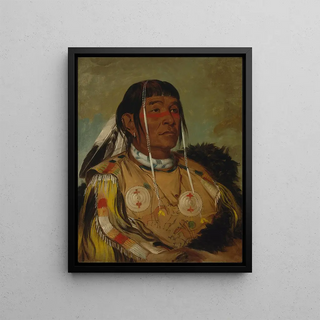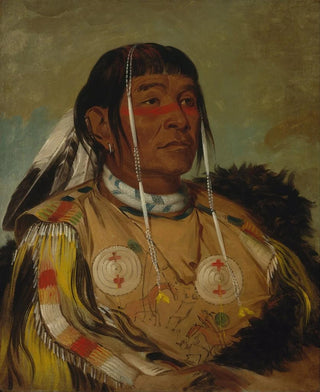Art print | Shacpay, the Six Chief of the Plains Ojibwe (Case Conflict) - George Catlin


View from behind

Frame (optional)
Art print Shacpay, the Six Chief of the Plains Ojibwe (Casus belli) - George Catlin – Engaging introduction
In the fascinating world of 19th-century American art, the work "Shacpay, the Six Chief of the Plains Ojibwe (Casus belli) - George Catlin" stands out for its ability to capture the essence of a culture in full transformation. George Catlin, painter and ethnographer, dedicated his career to immortalizing the Indigenous peoples of North America, offering a valuable visual testimony of a bygone era. This piece, both portrait and historical document, immerses us in the traditions and struggles of the Ojibwe, while questioning the complex relationship between art and collective memory.
Style and uniqueness of the work
Catlin's style is characterized by a realistic approach that combines precision and expressiveness. In "Shacpay, the Six Chief of the Plains Ojibwe (Casus belli)", every detail is carefully crafted, from the ornamentation of traditional clothing to the facial features of the chief, which reflect wisdom and strength of character. The vibrant color palette, typical of Catlin's art, evokes not only the natural environment of the plains but also the soul of the characters he depicts. The composition, centered on the chief, draws the viewer’s eye and invites deep contemplation, revealing tensions and hopes within a community facing modern challenges. This painting is not just an image, but a visual story that evokes powerful emotions and a rich history.
The artist and his influence
George Catlin, born in 1796, is often regarded as one of the pioneers of ethnographic art. His passion for Native American cultures led him to travel across the United States, where he met and documented numerous tribes. His work has not only contributed to the preservation of these cultures but also sparked growing interest in Indigenous peoples within 19th-century American society. Catlin used his art as a means of advocacy, raising public awareness of the injustices suffered by Indigenous populations. His influence endures today, inspiring

Matte finish

View from behind

Frame (optional)
Art print Shacpay, the Six Chief of the Plains Ojibwe (Casus belli) - George Catlin – Engaging introduction
In the fascinating world of 19th-century American art, the work "Shacpay, the Six Chief of the Plains Ojibwe (Casus belli) - George Catlin" stands out for its ability to capture the essence of a culture in full transformation. George Catlin, painter and ethnographer, dedicated his career to immortalizing the Indigenous peoples of North America, offering a valuable visual testimony of a bygone era. This piece, both portrait and historical document, immerses us in the traditions and struggles of the Ojibwe, while questioning the complex relationship between art and collective memory.
Style and uniqueness of the work
Catlin's style is characterized by a realistic approach that combines precision and expressiveness. In "Shacpay, the Six Chief of the Plains Ojibwe (Casus belli)", every detail is carefully crafted, from the ornamentation of traditional clothing to the facial features of the chief, which reflect wisdom and strength of character. The vibrant color palette, typical of Catlin's art, evokes not only the natural environment of the plains but also the soul of the characters he depicts. The composition, centered on the chief, draws the viewer’s eye and invites deep contemplation, revealing tensions and hopes within a community facing modern challenges. This painting is not just an image, but a visual story that evokes powerful emotions and a rich history.
The artist and his influence
George Catlin, born in 1796, is often regarded as one of the pioneers of ethnographic art. His passion for Native American cultures led him to travel across the United States, where he met and documented numerous tribes. His work has not only contributed to the preservation of these cultures but also sparked growing interest in Indigenous peoples within 19th-century American society. Catlin used his art as a means of advocacy, raising public awareness of the injustices suffered by Indigenous populations. His influence endures today, inspiring






